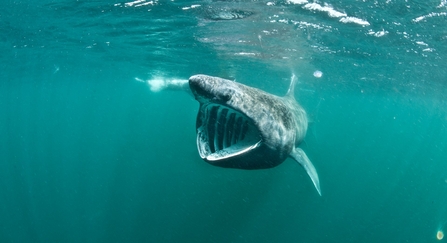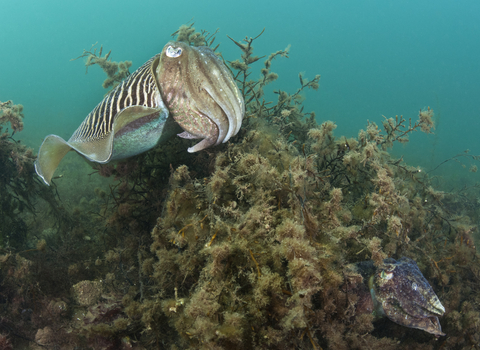Our seas are under pressure like never before; decades of over exploitation, pollution and unchecked development have resulted in continued biodiversity loss and the degradation of marine habitats.
But there is a way to help bring our seas back to life!
Highly Protected Marine Areas (HPMAs) are a new type of marine designation designed to allow marine life to recover. By giving special areas the best possible protection, they’ll benefit nature, people and the climate, too.
Thanks to the campaigning of The Wildlife Trusts and over 17,000 of our amazing supporters, the first three HPMAs have now been designated in English waters.

Alexander Mustard/2020VISION
What are Highly Protected Marine Areas?
Highly Protected Marine Areas (HPMAs) are a new type of marine designation designed to protect and recover marine ecosystems.
They give nature the best chance of recovery by safeguarding special areas with the best possible protections. All damaging activities, such as fishing, construction, digging and similar are banned in HPMAs. But don’t worry, they are not ‘no-go zones’! We can still enjoy these special places through all non-damaging activities, such as swimming, kayaking, scuba diving and surfing.
What will HPMAs protect?
HPMAs will protect everything within their boundaries following a ‘whole-site approach’. This means that the ecosystem, habitats, wildlife (including animals which live in the site and mobile animals which visit or pass through), abiotic elements, and their supporting ecosystem functions and processes are all protected.
Basically, if it’s in the HPMA it’s protected! This includes the seabed, water column and the sea surface.
Where are the HPMAs?
The first three sites were officially designated as HPMAs in England on 5th July 2023.
Learn more about these special places using the dropdowns below!
Allonby Bay, off Cumbria’s coast
Allonby Bay is an important inshore area, at the mouth of the Solway Firth.
Why is it so special?
It includes reefs of blue mussels and some of the best examples of honeycomb worm reefs in the UK. The habitats also store significant amounts of carbon and provide flood and coastal protection.
Wildlife found here
Allonby Bay is a spawning area for thornback rays, and thought to be an important breeding area for harbour porpoise. Seabirds such as guillemots frequently feed here.
Dolphin Head, in the English Channel
Dolphin Head is a diverse area offshore, approximately 55km from the Sussex coast.
Why is it so special?
The tide dominates this area, as it is influenced by swell from the Atlantic Ocean. However, years of damaging fishing activities have damaged the seabed.
Wildlife found here
The wonderful range of species found here, including lobsters, eels, and reef-building worms, attract dolphins and seabirds to feed.
North-East of Farnes Deep, in the northern North Sea
North-East of Farnes Deep is an area offshore with sediments teeming with life.
Why is it so special?
This area has subtidal sediments important for carbon storage, ocean quahogs, starfish, sea pens, anemones and fish.
Wildlife found here
As well as the above wildlife, dolphins, whales and harbour porpoises use this area. It’s a fantastic hotspot that deserves protection!
What will HPMAs do for people, nature and the climate?
Discover the benefits of HPMAs using the dropdowns below.
People
HPMAs will offer many benefits for people. They will provide excellent places for us to experience underwater wildlife. Our mental and physical health will benefit from spending time in and near HPMAs. By encouraging nature tourism and providing jobs for local people, coastal HPMAs will provide positive impacts to communities. Fishers in surrounding areas will find more fish to catch, as populations recover and spread to surrounding areas. HPMAs will also safeguard our seas for future discoveries by scientists and students.
Even those who live far away from the sea will benefit from knowing these special places are properly protected. Every second breath we breathe comes from the ocean - even more important for us to take care of it!
Nature
Our seas are damaged, and wildlife at risk, due to decades of overexploitation and development. The science is clear - by protecting all wildlife and habitats from damaging activities, HPMAs will give our seas the best chance to recover. This will provide the benchmark against which to measure the health of our seas and other marine protected areas.
Climate
HPMAs will help to combat climate change by protecting and restoring species and habitats which store carbon. By safeguarding coastal habitats, they will also help protect our coasts from erosion and flooding.
HPMAs will also help marine life to adapt to climate change. For example, storm events are expected to increase with climate change and we already know that wildlife in well-managed marine protected areas can recover from storm events faster than in unprotected areas.
Learn more about HPMAs
How are HPMAs different to existing marine protected areas?
Existing Marine Protected Areas (MPAs) are important designations, but many are in a degraded state and are coming under increasing pressure. With conservation objectives often set to ‘maintain’ and a features-based approach (only protecting specific features where they exist within the site, not the whole site) these areas are not delivering for nature’s recovery.
But in Highly Protected Marine Areas, all damaging activities are banned within the whole site. This new type of designation will allow nature to properly recover. HPMAs will set a high bar against which we can measure other protected areas.
Will more HPMAs be designated in the future?
Three HPMAs is a great first step towards recovering our seas, but unfortunately, it’s not enough to save our seas from the crisis they’re in.
Learn more about why three isn’t enough from Dr Lissa Batey, Head of Marine Conservation
The Government has committed to explore additional sites for consideration as HPMAs in 2023. The Wildlife Trusts are continuing to call for more of these special sites to provide the essential protection our seas need.
The History of HPMAs in England:
On World Oceans Day 2019, a review into Highly Protected Marine Areas was launched by the then Secretary of State Michael Gove. The review’s advisory panel, including Joan Edwards, Director of Marine Conservation at The Wildlife Trusts and led by former MP Richard Benyon, were tasked ‘To recommend whether and how HPMAs could be introduced in areas of sea within the UK Government’s competence’. To gather evidence, information and views on HPMAs, the review conducted a public consultation and engaged with a wide range of stakeholders through roundtables, meetings and site visits.
On World Oceans Day 2020, Defra published The Benyon Review into Highly Protected Marine Areas (HPMAs). The report makes a wide range of recommendations to Government on how to introduce HPMAs into English waters. Some of the key headlines include:
- HPMAs should be defined as areas of the sea that allow the protection and recovery of marine ecosystems. They should prohibit extractive, destructive and depositional uses and allow only non-damaging levels of other activities.
- HPMAs are an essential part of the UK Marine Protected Area network, and the government should introduce HPMAs in English waters.
- HPMAs should take a whole-site approach, protecting all species and habitats within their boundaries.
- A minimum of five pilot sites should be designated, with sufficient geographic spread to cover nearshore, inshore and offshore areas and different regional seas.
The Wildlife Trusts back all the report recommendations and believe HPMAs are an essential part of the UK’s network of designated sites to protect and recover the marine environment.
Following the publication of the Benyon Review, 11,822 people signed our campaign to show their support for HPMAs.
On World Oceans Day 2021, the Government responded to the Benyon Review and committed to designate a number of pilot HPMAs in English waters. Later that year, the Department for Environment, Food and Rural Affairs (Defra) invited stakeholders to propose areas for designation as HPMAs in English waters. The Wildlife Trusts submitted a number of proposed sites to this consultation, including Allonby Bay, Dolphin Head and North-East of Farnes Deep.
In July 2022, Defra launched a 12-week public consultation into five sites proposed for designation as HPMAs. We responded to this consultation and over 17,000 of our amazing supporters backed our call for at least five HPMAs to be designated, many leaving comments to tell the Government why HPMAs are important to them.
In February 2023, the Government committed to designate three pilot HPMA sites (above) before 6th July 2023, and to explore additional sites for consideration as HPMAs in the future.
Today, we’re working to ensure the first three pilot HPMAs are a success and are continuing to call on the Government to designate more of these vital sites.

